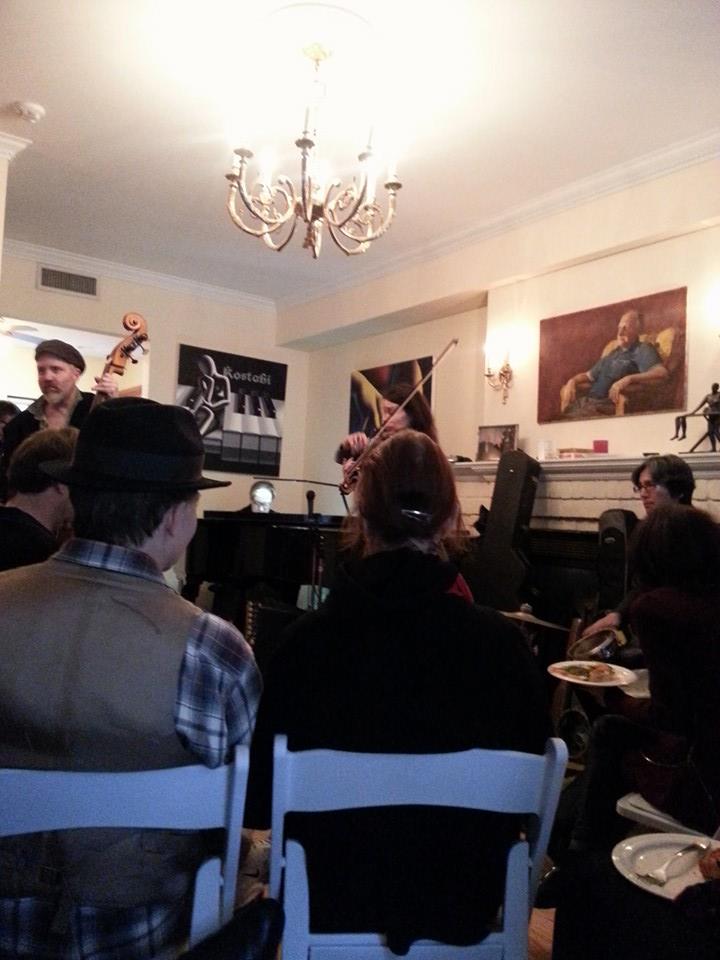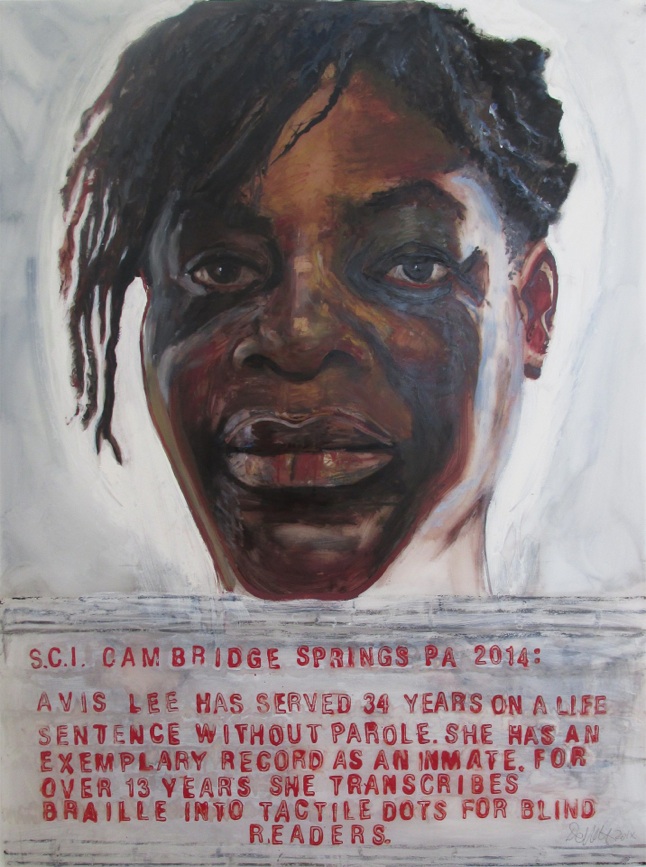Topic: COMMUNITY INTEREST
A Place of Paramount Peace in Robbinsville, NJ
By Dr. Tammy Duffy
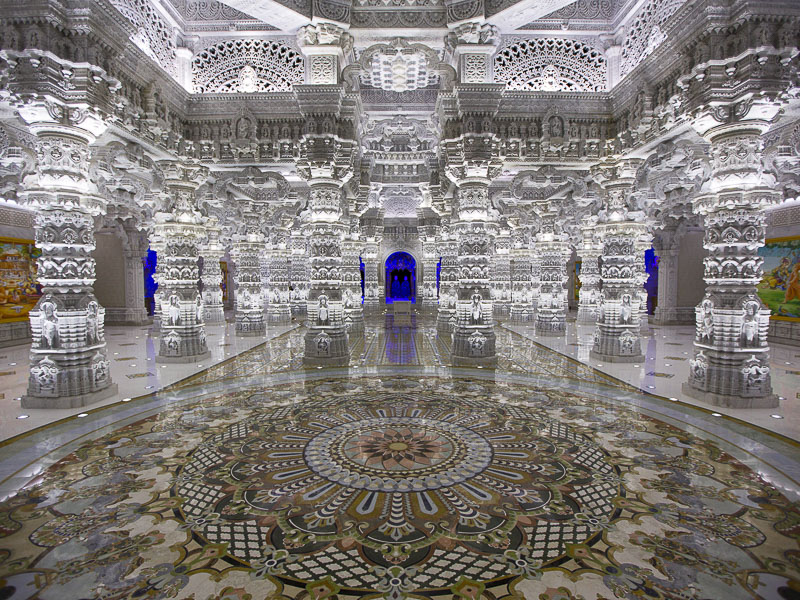
Religious architecture represents sacred space amid this profane world and has always played a pivotal role in the history of mankind.
There is a new architectural spiritual wonder that has been constructed on the site of the BAPS Shri Swaminarayan Mandir in Robbinsville, NJ. The construction began in early 2010. The Mandir was the second phase of the Hindu American Religious Center construction and was completed early in the overall project to facilitate a leveled growth of the center. In looking at the construction specifics, chiseled Italian carrana marble was used to build the 12,000 sq. ft. Mandir. Carrara marble has been used since the time of Ancient Rome. The marble is shipped from Italy to India where it is then carved by master sculptures. All of the exquisite work you see in the Mandir is done with a chisel and hammer. Despite heavy snowfall during the winter months, the mandir was completed in August of 2014.. A consecration ceremony was held on August 10th, 2014 in the presence of His Holiness Pramukh Swami Maharaj, senior swamis from India and devotees from across the world. During his visit His Holiness gave input on some of the design at the Mandir. There will be alterations made to accommodate his requests. (i.e. marble mosaics vs. paintings on the walls and the entrance changed to cover the bare internal walls that surround the mandir allowing people to visit 365 days a year.
Initially, after taking off your shoes and walking up the white marble staircase to enter the BAPS Shri Swaminarayan Mandir Hindu temple in Robbinsville, New Jersey, you may notice the floor is a little dusty. There are artists working behind a barricade adding to the temples splendor.
Once you enter, though, it's nearly impossible to look down as you take in how much detail is carved into every inch of the temple's Italian white marble surface. The scene is overwhelming. Each piece of iconography is different yet there is a precision to the symmetry of the designs. It is quite stunning as well that this is all done by volunteers. The devotion is overwhelming.
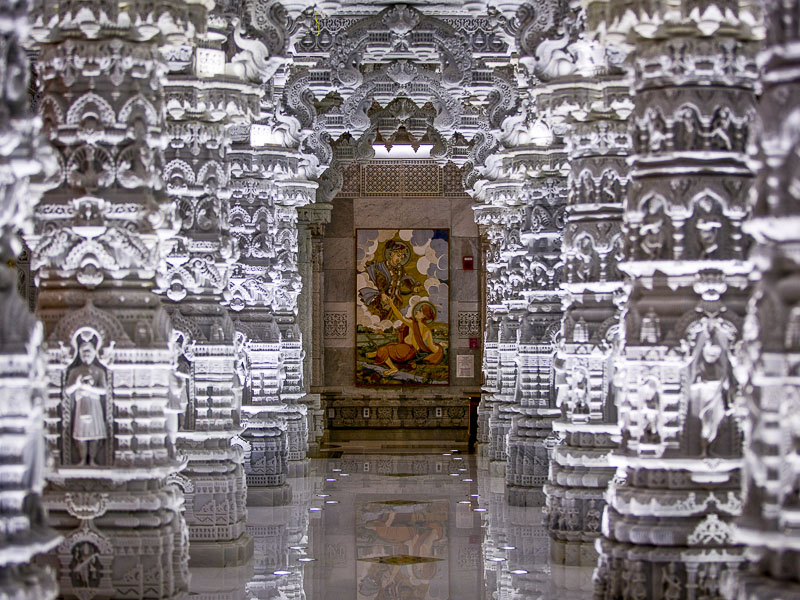
As soon as you walk in, what hits you the first time is the aesthetic appeal, the beauty. The positive energy is electric. The Robbinsville mandir, or Hindu house of worship, is one of only six traditional stone mandirs that exist in North America. The one in Robbinsville is the only one carved completely of marble.
The temple sits inside of a larger building to protect its surface from New Jersey's harsh winter weather. That shield could help it last more than 1,500 years. Pieces of the structure were hand-carved by 2,000 artisans in India and shipped over individually, where they were assembled in layers. The entire process, from the choice of stone to the completion of construction, has taken about five years.
Some of the most detailed carvings in the temple's surface feature peacocks and elephants which represent purity and strength and the lotus flower, which represents purity for its ability to grow in water yet manage to stay dry.
Several LED lights embedded into the floor accent the stone structures brilliantly, and provide depth to the carvings. The creators of the temple will be working with Yves Pepin on the expansion that is planned. Yves Pépin has built a worldwide reputation as one of the most innovative designers and one of the most successful artistic directors of ground-breaking entertainments.
Pepin was Artistic Adviser for the worldwide acclaimed Beijing 2008 Olympic Games Ceremonies where he did all the water and laser shows. Also, he produced the worldwide applauded pyrotechnic show on the Eiffel Tower for the Year 2000 handover.
Yves Pépin invented and developed, in the late 1980s, the film projection on waterscreen technology, adopted since then by several theme park operators including Disney, Universal Studios and others.

When architects come here to view it, they are marveled by what they see . They have difficulty understanding not only at the beauty of the design, but at how the entire structure is able to stay standing and support itself because it's so heavy.
Roughly 40,000 practicing Hindus live in the Central and South Jersey area, with several hundred thousand more in the tri-state area.. Although there are other mandirs in the area, the growing size of the congregation was enough to support construction of a traditional stone temple, one that can host special rituals.
An assembly hall adjoining the mandir structure will host weekly rituals. Plans to build a second, larger limestone mandir are already in place with completion expected in about 10 years. The entire complex sits on about 140 acres of land.
In speaking with Anil Patel, Public Relations Director at the Temple, he said, “They want to see that tradition is kept alive, I think, to me that's just most impressive and precious," said Patel.
His Holiness, Pramukh Sami Maharaj, the fifth spiritual successor of Bhagwan Swaminarayan, has inspired millions of people across the world t o lead a more moral life. The 92-year-old Guru Pramukh Swami Maharaj of India, one of the most respected spiritual leaders in the Hindu religion. He was here for the ceremonial placing of the first piece of marble as well. He is their leader.
The 5th, and last phase of the project, the Swaminarayan Akshardham Mahamandir is expected to be completed within the next 5-7 years. The foundation for the Mandir is complete, and the stone carving has begun in India. Phase 4, the Visitor's Center, will also house a small exhibition on Indian history and culture. Countless volunteer hours have gone in the design and planning for this project. The devotees have truly upheld their Guru’s vision and woven it into their mission. This is going to be a massive place when its finished. A beautiful spectacle for all to see.
In order to fully admire the Mandir’s beauty and grandeur,one must understand how the Mandir was made. The Mandir, built in the Nagaradi style, stands 42 feet tall, 133 feet long and 87 feet wide and is made entirely of Italian Carrara marble (68,000 cubic feet); only the third Mandir of its kind. The beautiful carvings seen around the Mandir are not only aesthetically appealing, but are also meaningful in many ways. For example, 98 pillars depict the lives of the great paramhansas (spiritual aspirants) and devotees of Bhagwan Swaminarayan. Their inspiring stories, as well as Bhagwan Swaminarayan’s key messages are incorporated throughout the Mandir.
In Sanskrit, Mandir means a place where the mind becomes still and experiences inner peace. In the Mandir, time stands still. I attended one of the daily Arti during my visit. Arti is a Hindu form of worship using lamps to illuminate the murtis of God, an expression of ones complete and unwavering love towards God. The tradition dates back thousands of years to the ancient mandirs of India. Having been raced Irish catholic, I found this ceremony particularly moving. The positive energy overcomes your entire body as you enter into the mandir. As the collection basket was passed one blessed themselves over a candle before placing money into the offering basket. I saw one woman have the ability to get change for a large bill prior to her offering. This would never happen in a catholic church, they would take your money, without blessing.

The shrine is the sacred centre of the mandir. It houses the temple deities and is usually situated at one end of the main hall. To the side or close by is a room in which the priests prepare for worship according to a fixed daily schedule. Often only the priests, freshly bathed and wearing clean clothes, are allowed to enter these sacred areas.
To begin with, each temple is dedicated to a particular god ,although representations of other gods are allowed. In fact, mandir actually means"dwelling." At the heart of the temple rests a shrine to the chosen deity. These shrines contain an image usually a statue or painting of the god. Each morning the priest adorns the shrine, surrounding the image with fresh flowers, fruit, incense, candles, lamps, and other decorations.
Hindus believe that although an image cannot contain God, deeper understanding can be achieved by meditating on a representation of Krishna, Vishnu, Brahma, or other deities. It is in this spirit that Hindus perform puja, daily worship. Temple pujas are performed at dawn, noon, dusk, and midnight. Participants take an active role in their worship, beginning with darshan, which simply means "to focus upon a deity." Next, the devotee makes a food offering. The priest blesses the prasad, or food, which is then consumed by the worshipper. It is also common for the priest to burn some of the gift and smear the consecrated ashes on the giver's forehead. Finally, some temples have room for followers to circle the shrine in a clockwise motion, another popular form of worship.
Traditionally, the outside walls of a mandir are decorated with sculptured representations of an array of mythic and worldly happenings. In fact, some older temples are literally carved out of rocks and caves. Some of these sculptures are magnificent, intricate works of art. Other temples are simple, unadorned buildings. Some rise into spires, or towers, symbolizing the meeting of the celestial and earthly. The entrance, usually facing east, welcomes the guest into a pillared hallway, an assembly hall, or both. These lead to the shrine room, the heart of the structure. Many temples also contain bathing tanks where devotees cleanse themselves.
Unlike the members of many other religions, Hindus may maintain their spiritual devotion without visiting their house of worship. As you will see, many worship their chosen deity at their family shrine. Still, the mandir serves an essential role in the spiritual life of a Hindu. It is a place where the world is left behind for awhile, a place of ritual, devotion, and cleansing.
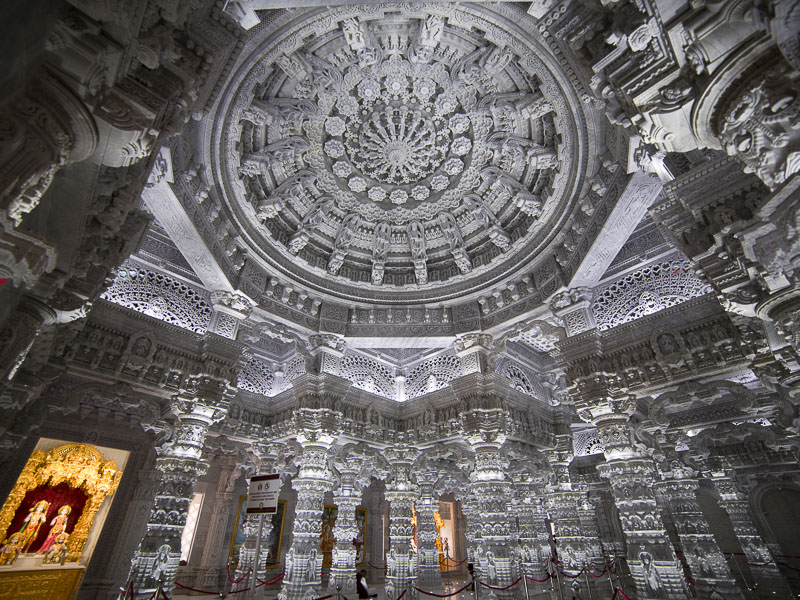
Mandir means "abiding place" or dwelling." It is the home of the god worshipped there. The main services at a mandir are at sunrise and sunset.
Since Vedic times, India's sages have been enlightened with profound spiritual truths that served as basis of their rituals, philosophies, scientific discoveries and religious faith. As an expression of their spiritual faith, the yogis evolved and created beautiful Mandirs to uphold these traditions. In a similar token, this Mandir aims to serve as a place of understanding and appreciation of India art, culture and religion for generations to come. It will stand as a sanctuary for countless men and women, who will be able to sustain their culture and heritage in the form of arts, language, music, and spiritual learning. The Mandir will provide a platform to encourage the act of giving back to our communities through various charitable efforts like Walkathons, Health Fairs, Blood Drives, flu shots, cultural programs for children, celebration dates of Hindu festivals, music and tabla classes for children, Gujarati classes for children, spiritual classes for all age groups.
The process behind building a magnificent Mandir such as this one is multifaceted. The stone marble was quarried in Europe and sent to India through sea cargos. Once the marble reached India, it was trucked to Rajasthan where hundreds of talented artisans would begin the work of hand carving the stones. All the pieces were first assembled at the workshops in India to ensure that they fit appropriately and accurately and were subsequently numbered, using a system developed by the onsite engineers. The pieces were then disassembled, packed with care and shipped to America, where the pieces were organized to begin the process of assembling the Mandir. From Europe to USA, each stone travelled a distance of 21,500 miles.
Encasing the Mandir is a beautiful Mandap made of Bulgarian Limestone standing 55 feet tall and 135 feet wide. The Mayur Dwar, or main gate, of the Mandap is adorned with 236 carved peacocks, and various other carved elephants, devotees and paramhansas. The Mandap allows for the Mandir to be enjoyed year round, and shielded from the elements, it will ensure that the Mandir will maintain its beauty for generations to come.When looking at it from this perspective, you can certainly gauge the complex process that was required to build such a grand scale Mandir. However, the efforts that are not seen to the naked eye were equally important while making this mandir. This Mandir, like all other BAPS Mandirs, is the epitome of volunteerism and serves as a symbol to show the value of sacrificing one’s time and efforts towards bettering the community. Volunteers of all ages have devoted their time and resources from the beginning: assisting in the construction work, cleaning up around the site, preparing food for all the artisans on a daily basis and helping with other tasks. A total of 4.7 million man hours were required by craftsman and volunteers to complete the Mandir. His Holiness Pramukh Swami Maharaj has continuously inspired everyone to dedicate their best efforts towards completing this Mandir that would serve as a platform for cultivating Hindu values and serving the community in many ways.
There are many structural details to the Mandir. There are 40 small Fasnakar style shikhars (spires),2 large and 8 small ghummats (domes),98 sthambhas (carved pillars),66 intricately carved peacock style arches,144 carved sacred figures,58 decorative ceiling designs,34 decorative grills,91 elephants with various musical instruments and flowers
44 Ganesh Murtis portrayed offering devotion to Bhagwan,and 13,499 individual carved stone pieces.
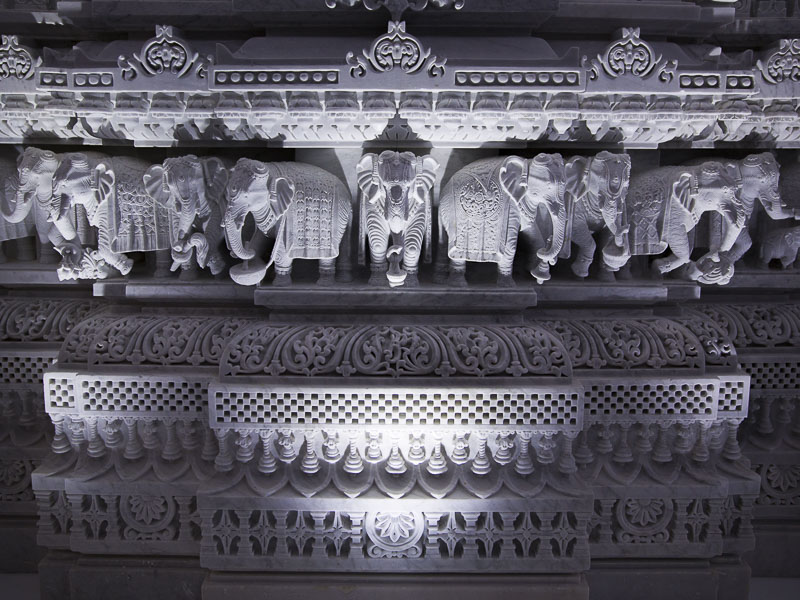
BPAS has been serving around the world for the past 40 years. After visiting the temple you can visit the gift shop that is filled with an array of prayer and gift items, incense, CD’s, DVD’s and spiritual books. I purchased a wonderful incense for just $2.00 and a wonderful spiritual book for just fifty cents.
There is also a wonderful Shayona, that upon entering it you can smell all the wonderful spices that are part of tradition in the culture. One has the ability to purchase the freshest ingredients and savory foods and sweets, indicative of the culture.
I also found it quite mind boggling that there were surrounding townships that refused to allow this amazing wonder of the world to be built. I am confident when those very political figures and directors of economic development of those towns will soon see the positive economic impact this will have. They no doubt will regret those unfortunate and uneducated decisions.
I highly recommend you visit this temple, no matter what your religious beliefs are. Everyone is welcomed and made to feel welcomed at the temple. The zen feeling that overcomes you upon entering enough to make you want to make a return trip the next day. When you are in the temple you are removed from the outside world and all its negative energy. I truly beautiful place to frequent. The Temple is located at 112 North Main Street, Robbinsville, NJ 08561.

